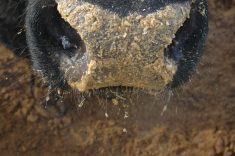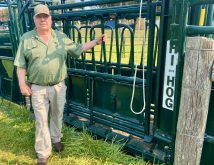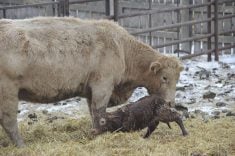Heavy blooms appear as a solid shimmering blue-green sheen across the dugout water’s surface with a “pea soup” quality
Cattle producers should be on the lookout for deadly bacteria that can grow in dugout water during the heat of summer.
“Cyanobacteria is actually much more common than people realize. It’s maybe not in all surface water sources, but in most it’s present,” said Joe Harrington, a water quality specialist in Lethbridge.
Often called blue-green algae, cyanobacteria produce toxins that can cause liver damage, gastroenteritis and even death if ingested by livestock.
Signs of poisoning include muscle tremors, paddling, watery or bloody diarrhea, cyanosis, convulsions and death. Symptoms usually appear two to 24 hours after ingestion.
In July 2017, more than 200 cows and calves were found dead in a former community pasture in southwestern Saskatchewan after they drank dugout water contaminated with cyanobacteria.
At the time, the animals’ value was estimated at $300,000.
According to the Saskatchewan government website, cyanobacteria typically have a shimmering, blue-green colour or a foamy sheen-like appearance that looks like spilled paint floating on the water surface.
Heavy blooms appear as a solid shimmering blue-green sheen across the water’s surface with a “pea soup” quality.
“You’ll see a shimmering green mat sort of thing on the water and then if you put a stick in it, it’ll look like paint on the stick. That is how you know you have the cyanobacteria present and then you’re going to want to treat for it,” said Adriane Good, livestock and feed extension specialist with Saskatchewan Agriculture.
“It can sometimes look like duckweed, which is a sign of a good dugout,” she added.
The bacteria thrive in heat and from nutrients that wash into water bodies or are added by livestock urine and feces. Wind can also concentrate the blooms in one area of a dugout where animals drink.
“Runoff does contribute as it’s carrying nitrogen and phosphorus into the water. The bacteria consume that nitrogen and phosphorus and uses it to grow,” said Good.
Harrington said cyanobacteria proliferate more with lots of sunlight and warmer water. However, the bacteria are most lethal when blooms die and the toxins are released.
Given lack of rain and prolonged heat over the past few years, producers should check their water sources. Evaporation leads to higher concentrations of salt and other minerals.
“Keep an eye on your water source and if it’s turning a green colour, that’s a good sign there may be cyanobacteria,” he said, noting it can be difficult to distinguish between algae and cyanobacteria.
“It can look many different ways. It’s not always blue and green. More often than not, it’s a grass green colour.”
Algae have a stringy quality that sticks to fingers, but cyanobacteria break into small pieces with no structural strength. Rubber gloves should be used if testing this quality because cyanobacteria at high concentrations can irritate the hands.
Harrington said water sources should be tested regularly, especially if it is hot and dry for an extended period.
However, it’s important to get a representative sample of the water, particularly when blooms are pushed around by wind.
“If they can get a sample that has a lot of that material in it and send it to one of the labs, they can test for microsystem toxins. They’re not testing for all the toxins, though. That is also another issue.
“There are no real magic tests that will say they’re safe or not. You still have to use a little bit of common logic.”
There are several ways to deal with a potential problem:
- Provide clean water for livestock.
- Check surface water sources and if algae problems occur, move cattle away from the water.
- Treat the water before there is a significant amount of algae.
- After treatment of a significant algae bloom, keep livestock away for about two weeks to allow toxins to dissipate.
The most common treatment for blue-green algae blooms are products containing copper sulphate in a liquid form. Other options include aluminum sulfate and hydrated lime.
“Cyanobacteria is quite sensitive to copper, where things like algae are not that sensitive to it,” said Harrington.

“More is not better than, in this case, because putting too much starts killing all the beneficial organisms within the dugouts such as zooplankton and things like that, that naturally keeps the environment in the dugout in balance.”
It’s critical that cattle are not given access to dugouts for 12 to 14 days after treatment because algae will release toxins as it dies.
“When the organism dies, it ruptures and releases that toxin out of the cell. That’s when the animal is at the most danger of getting a high dose of toxins,” said Harrington.
“So that’s why there’s always a recommendation about removing the animals. It’s not because of the copper. It’s because of the potential for these toxins to be concentrated in the water source.”
Surveys show most western Canadian beef producers do not test their water, which could be an expensive invite to problems.
“It’s really about managing the herd and paying attention to water sources; understanding that it’s critical and just keeping an eye on the animals and understanding what is potentially out there that could cause them problems,” said Harrington.


















